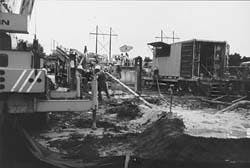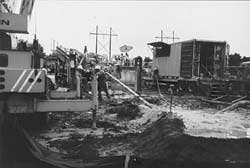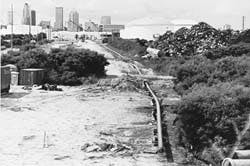FLORIDA PRODUCTS PIPELINE SET TO DOUBLE CAPACITY
Warren R. True
Pipeline/Gas Processing Editor
Directional drilling has begun this fall for a $68.5 million, approximately 110,000 b/d expansion of Central Florida Pipeline Co.'s refined products line from Tampa to Orlando (Fig. 1) (80110 bytes).
The drilling started in August and is scheduled to conclude this month, crossing under seven water bodies in Hillsborough, Polk, and Osceola counties:
Alafia River in Riverview: 999 ft (Fig. 2)Each crossing will take the pipeline at least 20 ft beneath the surface of a body of water.
WHAT'S HAPPENING
The current 6 and 10-in. system provides more than 90% of the petroleum products used in Central Florida, according to Central Florida Pipeline. Its additional capacity will meet the growing region's demand for gasoline, diesel, and jet fuel.
The new pipeline, along with the existing 10-in. system, will increase total annual capacity from 30 million bbl (82,192 b/d) to approximately 70 million bbl (191,781 b/d). The older 6- in. line will be shutdown when the new line is operating fully, says the company.
Estimated 1995 consumption of gasoline, diesel fuel, and jet fuel in greater Orlando is 35.8 million bbl, or 1.5 billion gal. Central Florida says it will be able to meet the region's needs well into the next century.
The new pipeline will consist of PLU3 API Grade 5LX-52 supplied by Mannesmann/Geneva Steel, Provo, Utah. Coating is coal tar TGF-3 from Consolidated Pipe & Supply, Birmingham, Ala.
Central Florida says main line construction will end in late January.
In current operations, the crew, typically 10 pipe layers and 10 directional drill operators, has spent approximately 2 weeks completing each drill with a drilling rig, an hydraulic power cab, an operator cab, a drilling mud mixer and pump, side booms, and welding equipment. The crew spent another week restoring the area to its previous condition.
The steps in the process are:
- A drillstring pipe begins by boring a 4-in. pilot hole on one side of the site.
- The 16-in. pipeline sections are welded together and pressure tested on the other side of the site.
- The crew-directed drill-string pipe breaks through the far side of the site and is attached to the 16-in. pipeline by a reamer.
- The drillstring pipe, reamer, and 16-in. pipeline are pulled back through the pilot hole.
- The pipeline, securely in place under the site, is pressure tested a second time.
Drilling contractor is ARB Inc., Broken Arrow, Okla.
CENTRAL FLORIDA
A subsidiary of the GATX Corp., Chicago, which holds 90% ownership of Central Florida Pipeline, began operating in 1965 and transports waterborne petroleum products from the Port of Tampa to the Orlando terminal along the CSX Railroad right-of-way (Fig. 1) (80110 bytes).
The original 6-in. line delivered jet fuel directly to McCoy Air Force Base (now Orlando International Airport) via a spur line. A 10-in. pipeline was added to the system in 1973 for delivery of gasoline, diesel fuel, and jet fuel.
The existing system has 24 main line valves to isolate pipeline sections; these are crucial in the pipeline's spill prevention and containment system.
Central Florida's annual throughput of approximately 30 million bbl breaks down into 11% No. 2 diesel oil, 16% kerosine/jet fuel, and 73% gasoline.
Main line take-off facilities are at Intercession City for the Florida Power Corp. and in Kissimmee for the Kissimmee Power Corp.
TERMINAL AT TAFT
The terminus of the Central Florida Pipeline is the Orlando terminal at Taft, Fla. It opened in 1965 and has a current storage capacity of 665,000 bbl. Ranging in capacities from 80,000 bbl to 190,000 bbl, 22 storage tanks store gasoline and diesel fuel for greater Orlando.
Central Florida declined to specify how the terminal is going to handle the additional volumes.
The terminal has five truck racks with 10 bays for tanker truck loading.
Currently, Central Florida provides more than 12,500 b/d of jet fuel to Orlando International Airport.
GATX Terminals is one of the largest independent bulk liquid storage and distribution systems in the world, with more than 75 million bbl of storage capacity. The company owns and operates 26 terminals in the U.S., 9 of which are associated with GATX Terminals' pipeline interests.
GATX Terminals also owns or has joint-venture interests in 14 international facilities, including 7 in the U.K.
The terminals provide links for distribution of petroleum and chemicals, providing an interface among virtually all modes of transportation. Services include tank storage; tank truck, tank car, vessel, and barge loading and unloading; pipeline receipt and shipment; blending of fuels; and other related services.
GATX Terminals holds interests in three refined-products pipelines. Calnev Pipe Line Co., San Bernardino, Calif., links the Los Angeles basin with Las Vegas, and is a wholly owned subsidiary of GATX Terminals.
Copyright 1995 Oil & Gas Journal. All Rights Reserved.


